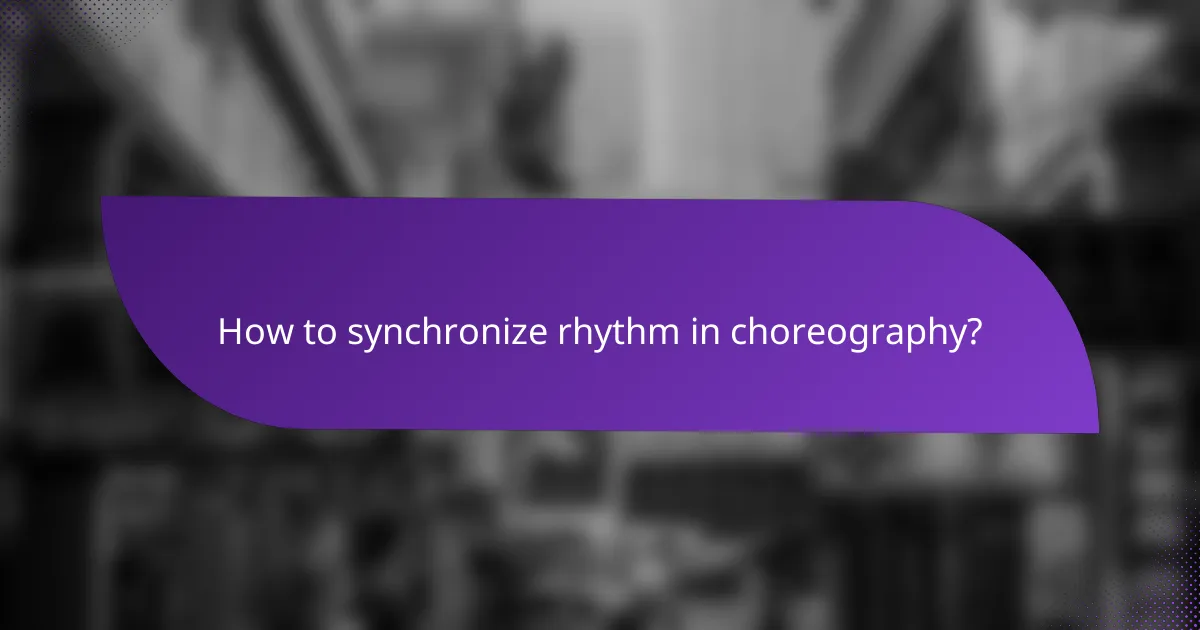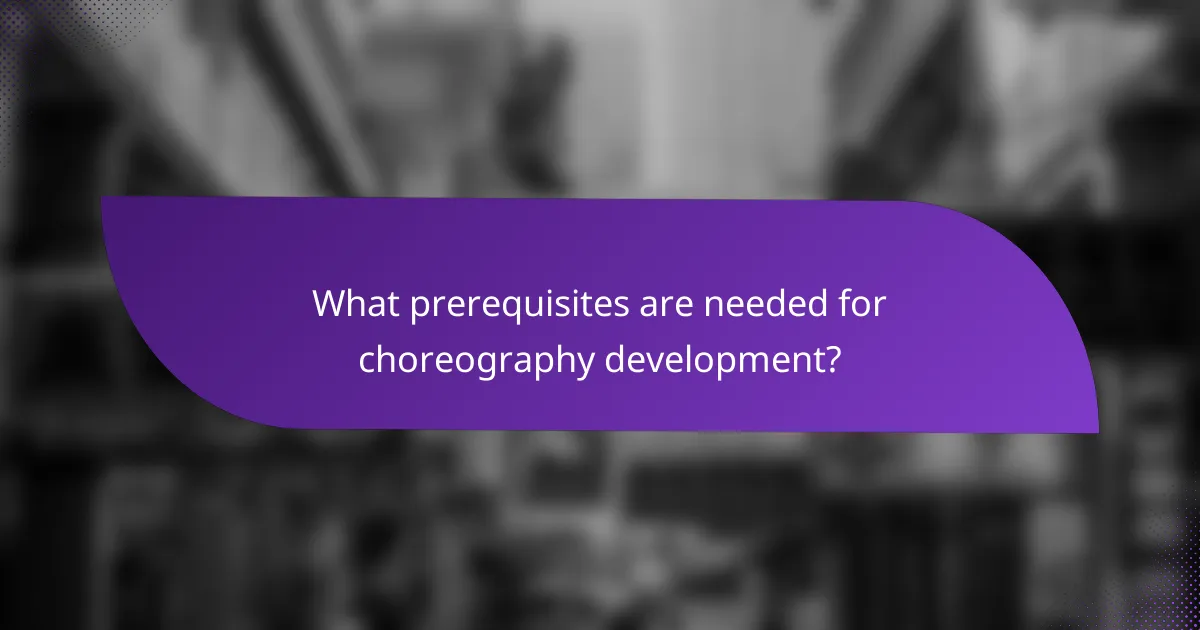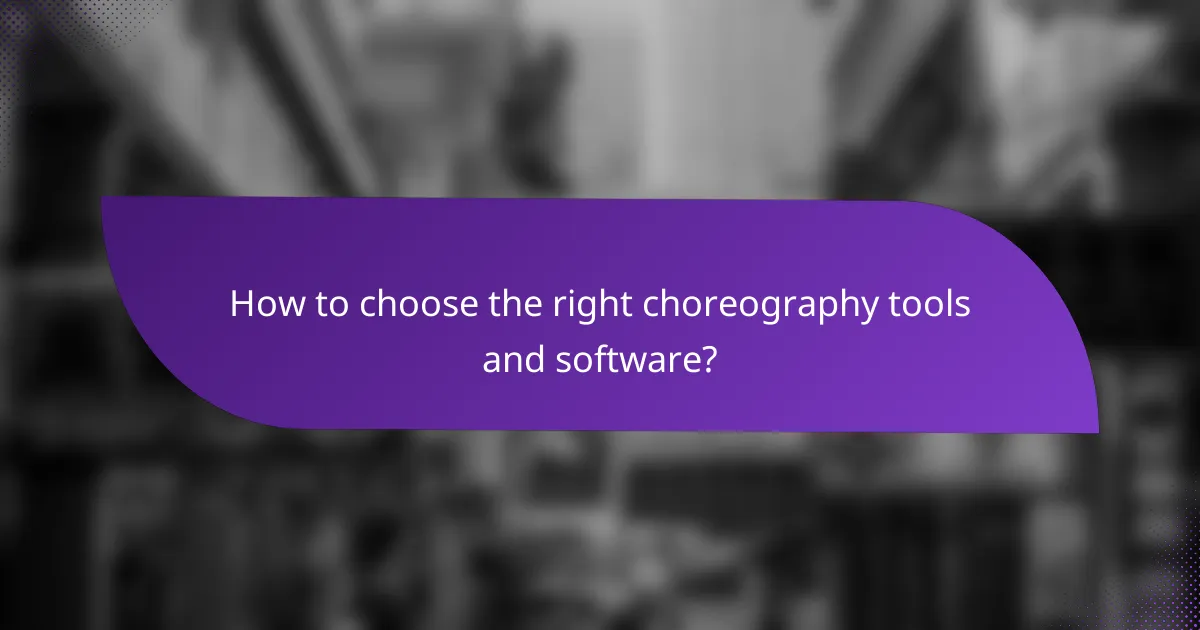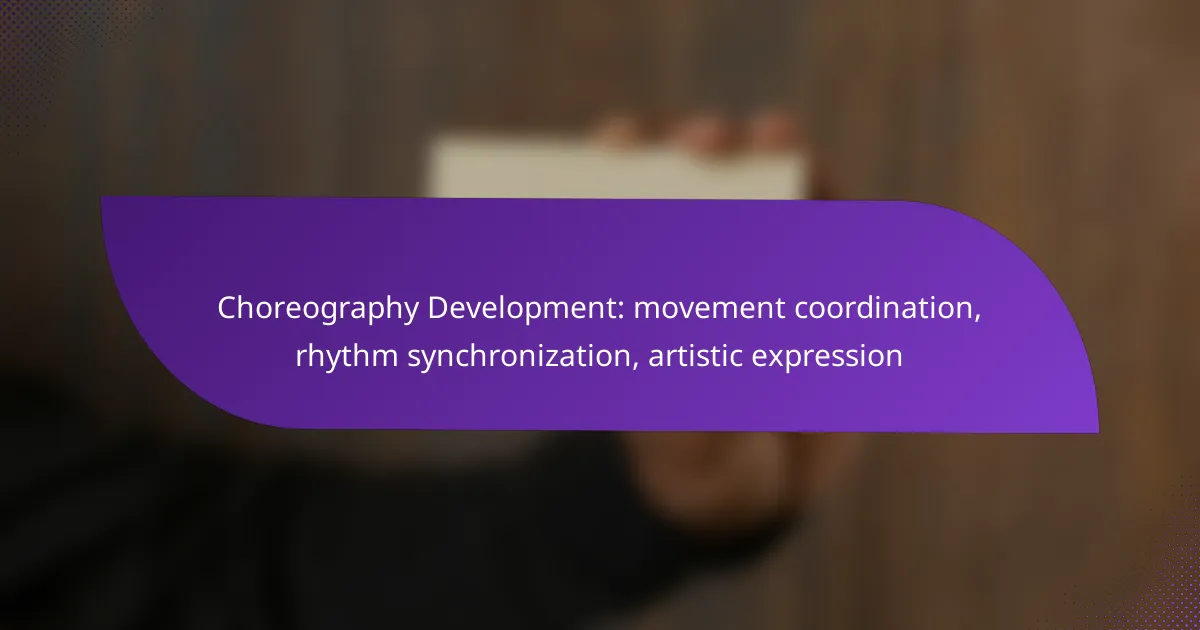Choreography development is a dynamic process that combines movement coordination, rhythm synchronization, and artistic expression to create compelling performances. By structuring movement sequences that align with music, choreographers can enhance the emotional impact of their work while fostering collaboration among dancers. Effective rehearsal techniques and continuous feedback are essential for refining these performances and achieving a seamless visual experience.

How to develop choreography for performances?
To develop choreography for performances, focus on creating structured movement sequences that align with music and rhythm while expressing artistic intent. This process involves collaboration with dancers, effective rehearsal techniques, and ongoing feedback to refine the performance.
Structured movement sequences
Structured movement sequences form the backbone of choreography, providing a clear framework for dancers. Start by outlining the key movements and transitions that will be used throughout the performance, ensuring they flow logically and enhance the overall narrative.
Consider using motifs or themes that can be repeated with variations to create cohesion. For example, a sequence might begin with a specific arm movement that evolves into different formations, allowing for both unity and diversity in the choreography.
Incorporating music and rhythm
Incorporating music and rhythm is essential for synchronizing movement with sound. Choose music that complements the emotional tone of the choreography and provides clear cues for timing. Pay attention to the beats and accents in the music to ensure that movements align with these elements.
Experiment with different styles of music to find what best supports the choreography. For instance, a contemporary piece may benefit from a more fluid and expressive musical choice, while a classical piece might require more precise and structured movements.
Collaboration with dancers
Collaboration with dancers is crucial for developing choreography that resonates. Engage dancers in the creative process by encouraging them to contribute ideas and interpretations of the movements. This collaboration can lead to more authentic and dynamic performances.
Hold workshops or brainstorming sessions where dancers can experiment with different movements and express their artistic input. This not only fosters a sense of ownership but also enhances the overall quality of the choreography.
Rehearsal techniques
Effective rehearsal techniques are vital for refining choreography. Schedule regular practice sessions that focus on different aspects of the performance, such as timing, spacing, and expression. Use video recordings to analyze movements and identify areas for improvement.
Incorporate varied rehearsal formats, such as full run-throughs and focused drills, to keep the dancers engaged and address specific challenges. This approach helps build confidence and ensures that the choreography is performed consistently.
Feedback and iteration
Feedback and iteration are key to developing successful choreography. Create a feedback loop where dancers can share their thoughts on the movements and overall performance. This can lead to valuable insights that enhance the choreography.
Be open to making adjustments based on feedback, and encourage dancers to experiment with their interpretations. Iteration allows for continuous improvement, ensuring that the final performance is polished and impactful.

What are effective techniques for movement coordination?
Effective techniques for movement coordination include exercises that enhance timing, balance, and synchronization with others. These methods help dancers and performers work seamlessly together, improving overall performance quality.
Partner work exercises
Partner work exercises focus on developing mutual trust and timing between dancers. Activities like mirroring, where one dancer imitates the movements of another, can enhance coordination and responsiveness. Additionally, practicing lifts and supported movements requires clear communication and physical awareness, fostering a deeper connection.
To maximize the benefits, partners should maintain eye contact and verbal cues to ensure synchronization. Regular practice of these exercises can lead to improved performance and a more cohesive dance style.
Body awareness practices
Body awareness practices help dancers understand their own movements and how they relate to others. Techniques such as yoga or Pilates can enhance flexibility and strength, allowing for better control over one’s body. These practices encourage mindfulness, which is crucial for recognizing how movements affect coordination.
Incorporating exercises that focus on core stability can also improve overall body awareness. Dancers should aim to engage their core muscles during movements, as this will provide a solid foundation for coordination with partners.
Spatial awareness drills
Spatial awareness drills are essential for understanding the space around oneself and others during performances. Activities like navigating through a crowded space or practicing formations help dancers learn how to adjust their movements in relation to others. This skill is vital for avoiding collisions and ensuring smooth transitions.
To enhance spatial awareness, dancers can practice moving in different formations or using props to visualize their space. Regularly engaging in these drills can significantly improve a dancer’s ability to coordinate movements with others in various performance settings.

How to synchronize rhythm in choreography?
To synchronize rhythm in choreography, dancers must align their movements with the musical beat, ensuring that each action corresponds to the rhythm of the music. This coordination enhances the overall performance and creates a cohesive visual experience.
Using metronomes for timing
Metronomes are essential tools for maintaining consistent timing in choreography. By setting a specific beats-per-minute (BPM) rate, dancers can practice their movements in sync with the metronome’s audible clicks, which helps establish a steady rhythm.
When using a metronome, start with a slower tempo to master the choreography before gradually increasing the speed. This approach allows dancers to build confidence and precision in their movements, ensuring that they remain in sync with the music.
Counting beats and phrases
Counting beats and phrases is crucial for understanding the structure of a piece of music. Dancers should familiarize themselves with the time signature, which indicates how many beats are in each measure, allowing them to anticipate changes in rhythm and adjust their movements accordingly.
A common method is to count in groups of four or eight, corresponding to musical phrases. For example, in a 4/4 time signature, dancers can count “1-2-3-4” for each measure, helping them stay aligned with the music’s flow.
Musicality training
Musicality training enhances a dancer’s ability to interpret and express music through movement. This involves developing an ear for rhythm, melody, and dynamics, which allows dancers to respond more intuitively to the music.
Incorporating exercises that focus on improvisation and musical interpretation can strengthen a dancer’s connection to the music. Regular practice with various musical styles can also improve adaptability and enhance overall performance quality.

What are the key elements of artistic expression in choreography?
The key elements of artistic expression in choreography include emotional storytelling, personal style development, and the use of symbolism. These components enable choreographers to convey deeper meanings and connect with audiences on an emotional level.
Emotional storytelling
Emotional storytelling in choreography involves using movement to express feelings and narratives. Choreographers often draw from personal experiences or universal themes to create a storyline that resonates with viewers.
To effectively convey emotions, consider the dynamics of movement, such as speed, force, and flow. For instance, sharp, quick movements might represent anger, while slow, fluid motions could depict sadness or tranquility.
Personal style development
Developing a personal style in choreography is crucial for artistic expression. This involves blending various dance techniques and influences to create a unique voice that reflects the choreographer’s identity.
Choreographers can explore different genres, such as contemporary, ballet, or hip-hop, and incorporate elements from each to find their signature style. Experimenting with improvisation can also help in discovering new movement patterns and expressions.
Use of symbolism
The use of symbolism in choreography allows for deeper layers of meaning within a performance. Choreographers often employ specific movements, gestures, or props to represent broader concepts or themes.
For example, a dancer’s outstretched arms might symbolize freedom, while a circular formation could represent unity. Understanding cultural symbols can enhance the impact of the choreography, making it more relatable to diverse audiences.

What prerequisites are needed for choreography development?
Choreography development requires foundational skills in dance, a solid understanding of music, and knowledge of various dance styles. These prerequisites enable choreographers to create cohesive and expressive movement sequences that resonate with audiences.
Basic dance training
Basic dance training is essential for anyone looking to develop choreography. This training typically includes learning fundamental techniques, body alignment, and movement vocabulary across different styles. A strong foundation allows choreographers to manipulate movements effectively and create innovative routines.
Consider enrolling in classes that focus on various dance forms, such as ballet, jazz, or contemporary. This exposure not only enhances physical skills but also fosters creativity in movement combinations.
Understanding of music theory
A solid grasp of music theory is crucial for successful choreography development. Understanding rhythm, tempo, and musical structure helps choreographers synchronize movements with the music, enhancing the overall performance. This knowledge allows for more nuanced interpretations of the music through dance.
Familiarity with musical elements such as beats, measures, and phrasing can aid in creating dynamic choreography. Listening to a variety of music genres can also inspire movement ideas and improve rhythmic accuracy.
Knowledge of dance styles
Knowledge of various dance styles enriches a choreographer’s toolkit, allowing for diverse expression and creativity. Each style has its own techniques, aesthetics, and cultural significance, which can influence choreography. Understanding these differences helps in blending styles or creating fusion pieces.
To gain this knowledge, attend performances, workshops, and classes across multiple genres. This exposure will not only broaden your understanding but also inspire unique choreography that reflects a blend of influences.

How to choose the right choreography tools and software?
Selecting the right choreography tools and software involves considering your specific needs, budget, and the features that enhance movement coordination and rhythm synchronization. Look for user-friendly interfaces, compatibility with various devices, and the ability to support artistic expression through customizable options.
Popular choreography software
Several software options cater to choreographers, each offering unique features. Some of the most popular include DanceForms, which allows for detailed floor plans and movement notation, and Choreographer’s Toolbox, known for its intuitive interface and real-time feedback capabilities.
Other notable mentions are Notator, which focuses on dance notation and analysis, and iDance, an app that provides a platform for creating and sharing choreography. When choosing software, consider factors like ease of use, community support, and available tutorials.
It’s also beneficial to explore free trials or demo versions of these tools to assess their fit for your choreography style. Many platforms offer subscription models, so evaluate your budget against the features you need for effective choreography development.
